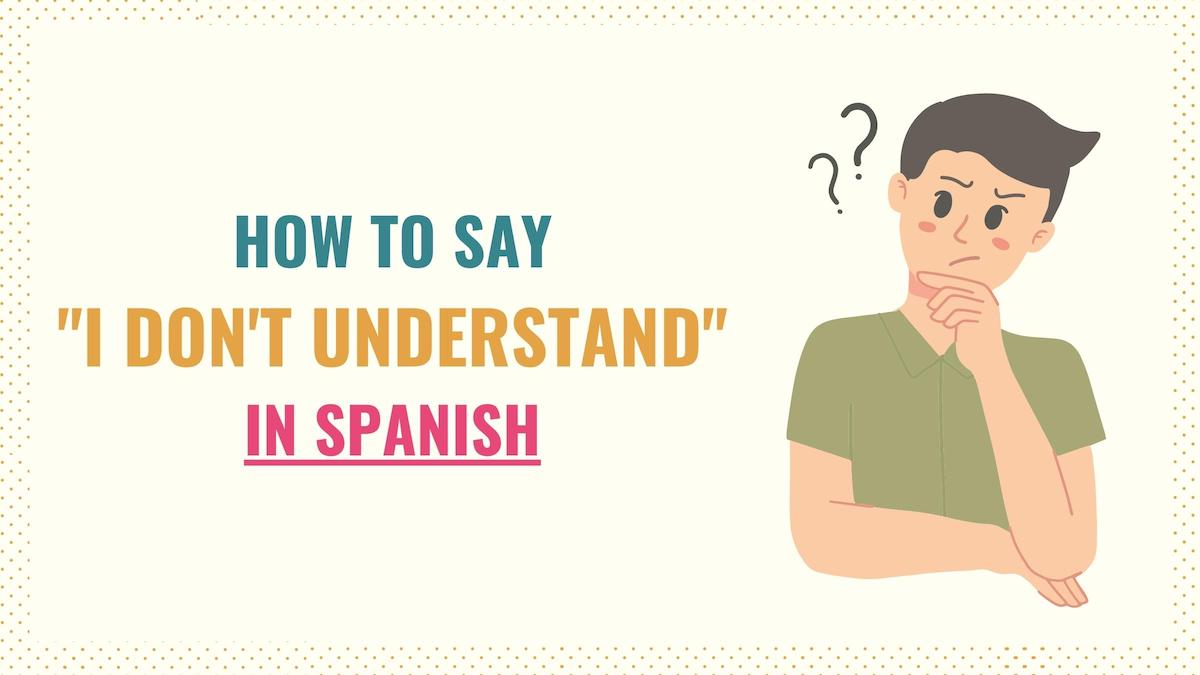When learning Spanish, you might find yourself in situations where you don’t understand what another person is saying – especially in the beginning! Since this is a common situation for many learners, people often wonder how to say I don’t understand.
So, in this article, I’ve compiled 5 common expressions you can use for this purpose. I’ve included examples and small descriptions to make this easier for you. By the end of this, you’ll be able to say I don’t understand like a native Spanish speaker.
1. No entiendo – I don’t understand
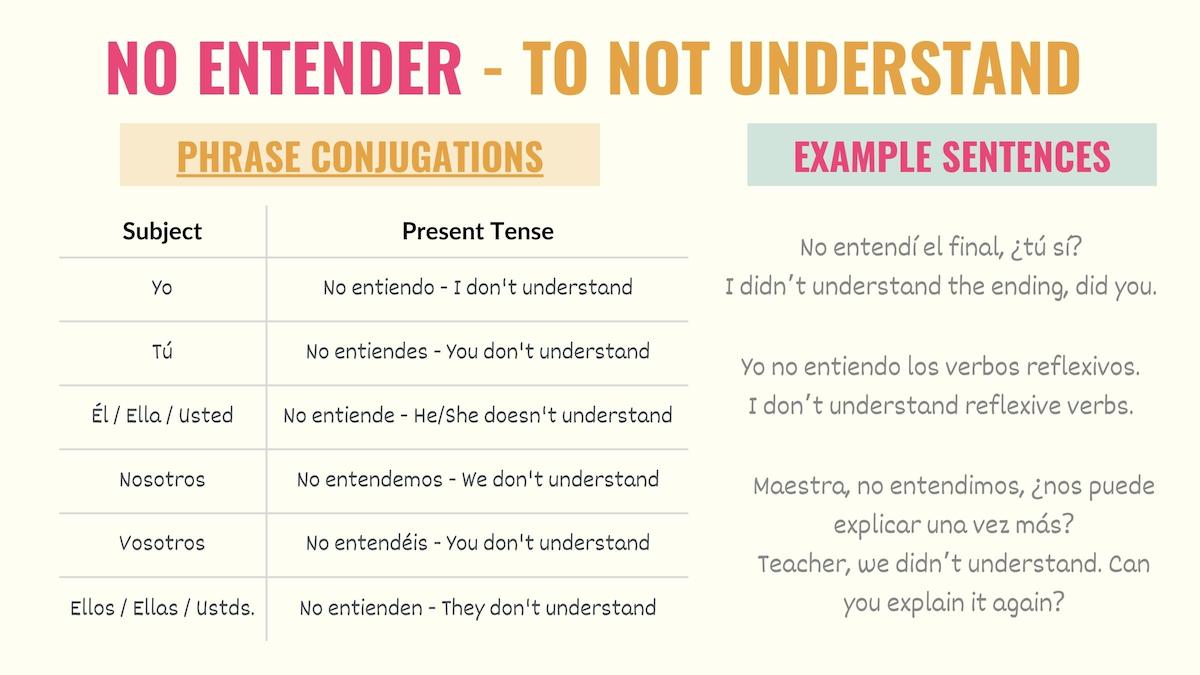
Infinitive form: “no entender” / “to not understand”
No entiendo is the most common way to say that you don’t understand something. You can use this Spanish phrase in both formal and informal situations.
Here are some examples of how to use this expression:
No + [entender conjugated] + [article] + [noun]
No entendí el final, ¿tú sí?
I didn’t understand the ending, did you?
Yo no entiendo los verbos reflexivos.
I don’t understand reflexive verbs.
You can conjugate the verb entender to the past tense to explain that you didn’t understand something:
Maestra, no entendimos, ¿nos puede explicar una vez más?
Teacher, we didn’t understand. Can you explain it again?
2. No comprendo – I don’t understand
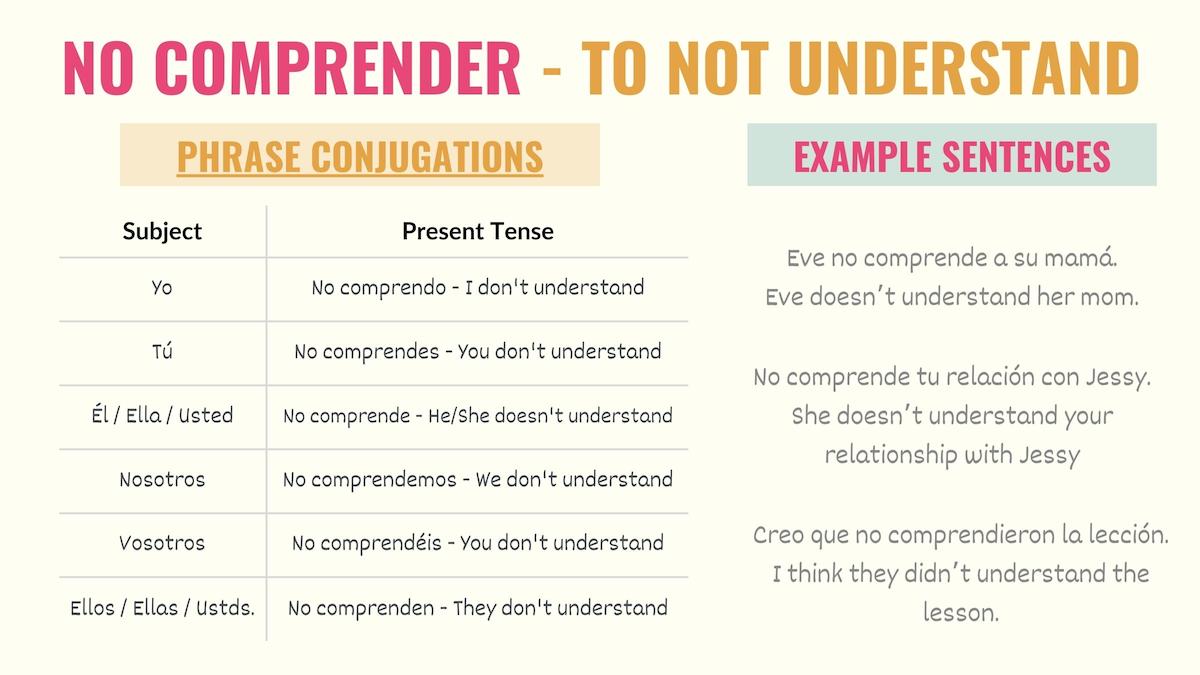
Infinitive form: “no comprender” / “to not understand”
Another common expression that means ‘I don’t understand’ is no comprendo. Depending on the Spanish-speaking country you’re in, ‘no comprendo’ can be slightly more formal than ‘no entiendo’. However, this is still a very popular expression that you can use in all contexts.
Here is a basic phrase structure and some examples that you can use. Notice that you can conjugate comprender to express when or who doesn’t understand something:
No + [comprender conjugated] + [complement]
Eve no comprende a su mamá.
Eve doesn’t understand her mom.
Creo que no comprendieron la lección.
I think they didn’t understand the lesson.
The following phrase structure can be used to express that you don’t understand a person’s behavior or actions.
No + [comprender conjugated] + [questioning word] + [complement]
No comprendí qué pasó.
I didn’t understand what happened.
Maestra, no comprendí qué dijo. ¿Puede repetir por favor?
Teacher, I didn’t understand what you just said. Can you repeat again please?
Take Note: Verbal periphrasis can help you improve your Spanish. In this case, seguir sin comprender is a popular structure that you can use to express that you still don’t understand something.
Sigo sin comprender qué es lo que buscas.
I still don’t understand what you’re looking for.
3. No me queda claro – It’s not clear to me
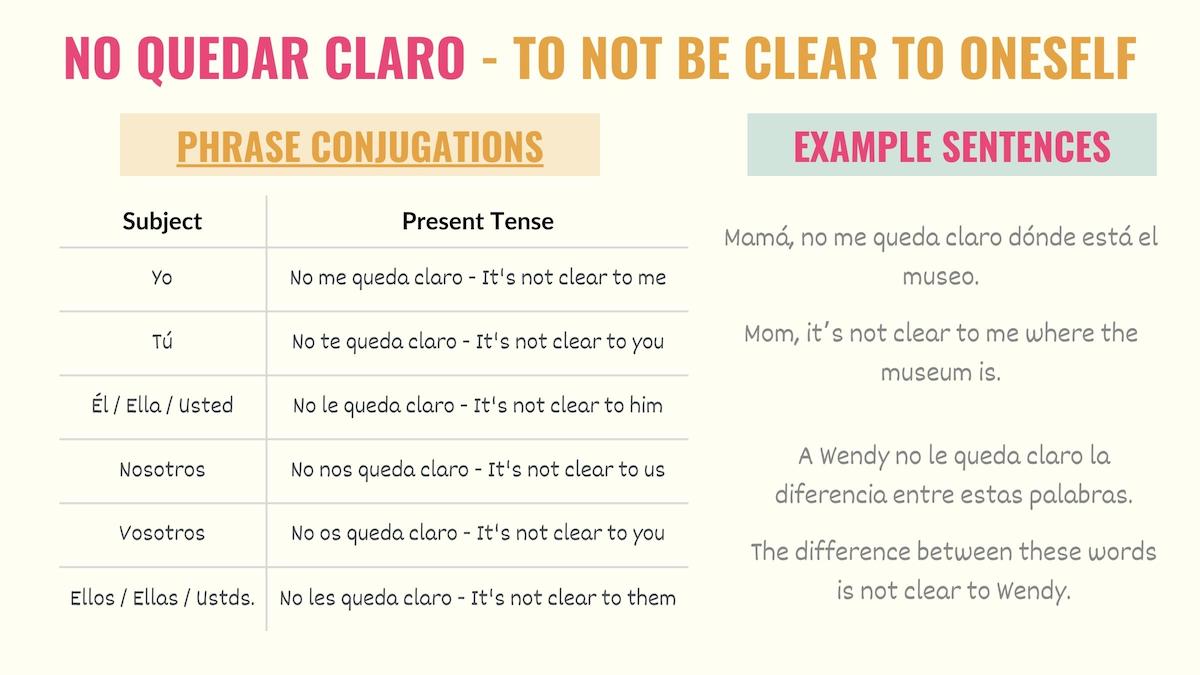
Infinitive form: “no quedar claro” / “to not be clear to oneself”
No me queda claro is a more casual phrase that you can use to say ‘I don’t understand’ in Spanish. Due to its informality, this expression is more suitable for use among friends, family and acquaintances.
Although you can use it in multiple contexts, this expression is especially useful when someone is trying to explain something and you don’t fully understand. Like other expressions from this list, you can use no me queda claro to refer to concepts (nouns) or actions/activities.
Below there are some examples and structures that you can follow.
[No] + [indirect object pronoun] + [quedar conjugated] + [questioning word] + [verb]
Mamá, no me queda claro dónde está el museo.
Mom, it’s not clear to me where the museum is.
¿No te quedó claro qué teníamos que hacer?
It wasn’t clear to you what we needed to do?
Maestra, no me queda claro cómo conjugar verbos reflexivos.
Teacher, it’s not clear to me how to conjugate reflexive verbs.
If instead of actions you want to say that you don’t understand a concept or topic, you can follow these examples. Notice that the noun can be placed either at the beginning or end of the sentence:
[No] + [indirect object pronoun] + [quedar conjugated] + [noun]
El subjuntivo no me queda claro.
The subjunctive is not clear to me.
A Wendy no le queda claro la diferencia entre estas palabras.
The difference between these words is not clear to Wendy.
4. No te sigo – I’m not following you
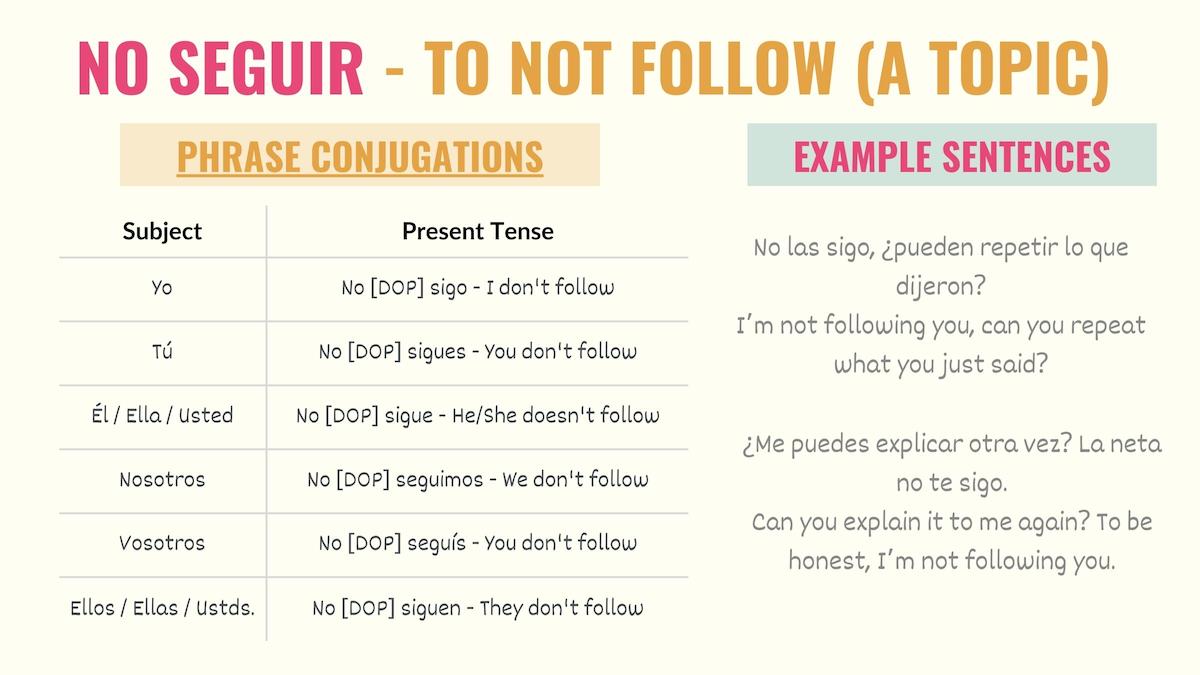
Infinitive form: “no seguir” / “to not follow (a topic)”
Given that no te sigo is the direct translation of ‘I am not following you’, this expression is a popular and casual way to express that you don’t understand something. Due to its characteristics, no te sigo is more suitable for informal contexts.
Check the examples below to see how to apply this expression to your conversations. Notice that, as mentioned before, you can conjugate this expression in present progressive to emphasize that you’re not understanding something at the moment of speaking.
No + [direct object pronoun] + [seguir conjugated]
No las sigo, ¿pueden repetir lo que dijeron?
I’m not following you, girls, can you repeat what you just said?
Oigan, no estoy siguiendo nada de lo que dicen.
Hey, I’m not following anything you say.
¿Me puedes explicar otra vez? La neta no te sigo.
Can you explain it to me again? To be honest, I’m not following you.
Take Note: No te sigo is never used to say that you didn’t understand something. As a result, you cannot use this expression in the past tense.
5. No capto – I don’t get it
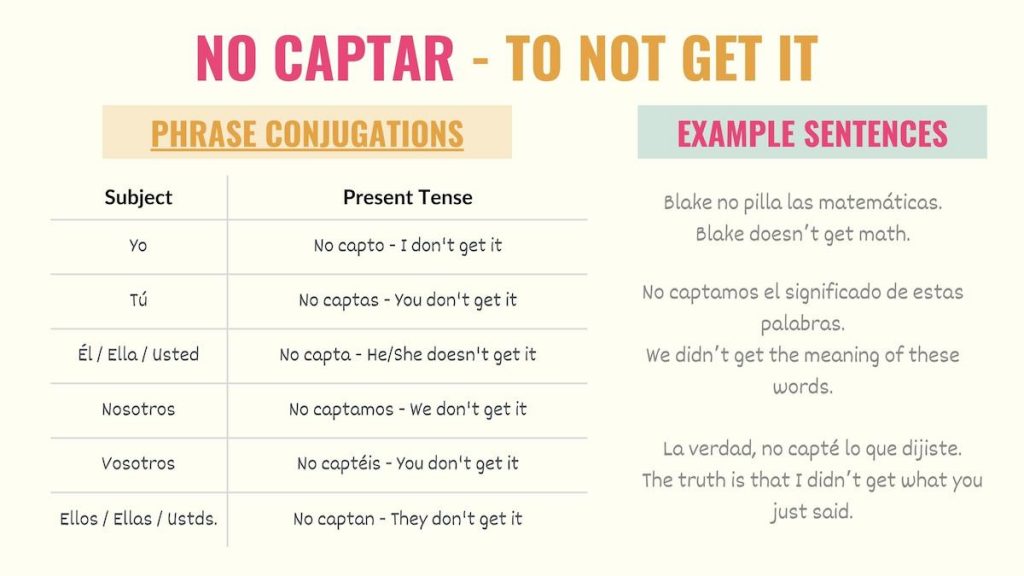
Infinitive form: “no captar” / “to not get it”
In Spanish, no capto is the direct translation of ‘I don’t get it’. As a result, this is an informal structure that you use as a synonym of ‘no entiendo’. No capto tends to be more popular in Latin American Spanish-speaking countries while no lo pillo is exclusively used in Castilian Spanish.
Just like other expressions from this list, no capto can be used when expressing that you don’t understand a concept, action or behavior.
No + [captar conjugated] + [determiner] + [noun]
Blake no pilla las matemáticas.
Blake doesn’t get math.
¿Por qué se enojó Molly? No capté.
Why did Molly get mad? I didn’t get it.
Andy y yo no captamos el significado de estas palabras.
Andy and I didn’t get the meaning of these words.
Notice that in some cases you can omit the noun because the information is clear enough. Below there is a structure that you can use to express that you don’t understand a behavior or action.
No + [captar conjugated] + [lo] + [que] + [verb]
La verdad, no capté lo que dijiste
The truth is that I didn’t get what you just said
Mark no capta lo que Evelyn le dice
Mark doesn’t get what Evelyn is telling him
Wrapping Up
Being able to say I don’t understand in Spanish will allow you to clarify things and concepts right away. For that reason, in this article, we’ve gone over the five most common expressions you can use in this context.
Hopefully, now you know more expressions other than no entiendo and you can start applying them in your conversations.

